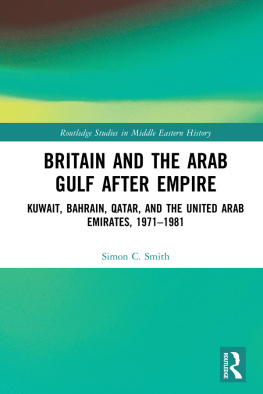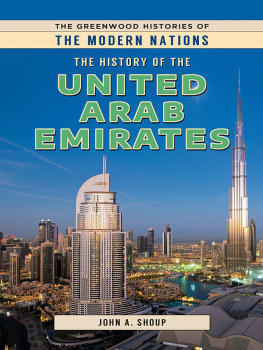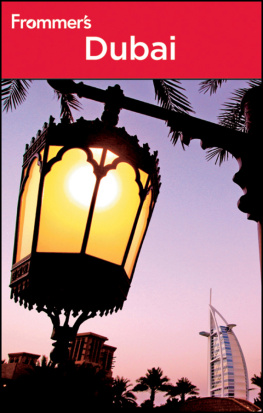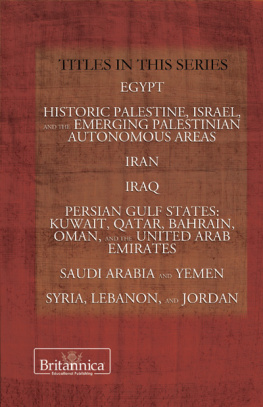ROUTLEDGE LIBRARY EDITIONS: WOMEN IN ISLAMIC SOCIETIES
Volume 3
THE WOMEN OF THE UNITED ARAB EMIRATES
The Women of The United Arab Emirates
Linda Usra Soffan
First published in 1980 by Croom Helm Ltd
This edition first published in 2017
by Routledge
2 Park Square, Milton Park, Abingdon, Oxon OX14 4RN
and by Routledge
711 Third Avenue, New York, NY 10017
Routledge is an imprint of the Taylor & Francis Group, an informa business
1980 Linda U. Soffan
All rights reserved. No part of this book may be reprinted or reproduced or utilised in any form or by any electronic, mechanical, or other means, now known or hereafter invented, including photocopying and recording, or in any information storage or retrieval system, without permission in writing from the publishers.
Trademark notice : Product or corporate names may be trademarks or registered trademarks, and are used only for identification and explanation without intent to infringe.
British Library Cataloguing in Publication Data
A catalogue record for this book is available from the British Library
ISBN: 978-1-138-20332-7 (Set)
ISBN: 978-1-315-44956-2 (Set) (ebk)
ISBN: 978-1-138-69617-4 (Volume 3) (hbk)
ISBN: 978-1-315-52521-1 (Volume 3) (ebk)
Publisher's Note
The publisher has gone to great lengths to ensure the quality of this reprint but points out that some imperfections in the original copies may be apparent.
Disclaimer
The publisher has made every effort to trace copyright holders and would welcome correspondence from those they have been unable to trace.
THE WOMEN OF THE UNITED ARAB EMIRATES
Linda Usra Soffan
1980 Linda U. Soffan
Croom Helm Ltd, 2-10 St John's Road, London SW11
British Library Cataloguing in Publication Data
Soffan, Linda Usra
Women of the United Arab Emirates.
1. Women - United Arab Emirates - Social Conditions
I. Title 301;41'.2'09535 HQ1731.5
ISBN 0-7099-0301-4
Published in the USA 1980 by
Harper & Row Publishers, Inc.,
Barnes & Noble Import Division
ISBN 0-06-496396-9
Library of Congress Card Number: 79-57324
To my family, with deepest appreciation and affection
Printed and bound in Great Britain by
Redwood Burn Limited Trowbridge & Esher
This project would not have been possible without the encouragement and assistance of many people and organizations. the UAE Ministries of Culture and Information and Labor and Social Affairs very generously provided the necessary funds for such research as well as contacts with local women's societies, showing riot only that they were ready to have such a study done, but, also, that they were willing to consider any recommendations made in the study. I must express my sincere gratitude to 'Abdullah Al-Nuwais, Deputy Minister of Information; 'Abdullah Al-Mazrouie, former Minister of Labor and Social Affairs; and 'Abdullah Abu-Sheehab, Deputy Minister of Labor and Social Affairs.
I would also like to thank Misses Nuhad Kanawaty and Fouda Outa of the local UNICEF office in Abu Dhabi for providing me with useful information on the activities of international organizations in the area.
In the preparation of this study, which is mainly based on my PhD dissertation at the Johns Hopkins School of Advanced International Studies, my adviser, Professor Majid Khadduri, gave me excellent guidance and encouragement at all stages of the project. Dr George Rentz also offered his advice and encouragement. I wish to thank them both.
My thanks are also due to Mary Ann Knotts and Lamin Sise for reading the manuscript in its entirety and offering valuable suggestions.
Had it not been for the cooperation of the female members of the ruling families in the UAE who so warmly received me and made my trip a most memorable one, this project could not have materialized. In particular, I wish to thank Shaykhas Fatima bint Mubarak, Moza bint Hilal, Noura al-Qasimi, Umm 'Ammar, and Mariam Al-Mu'alla.
Finally, my deepest gratitude goes to my husband, Fahim Sultan Al-Qasimi. Had it not been for his unfailing support and encouragement, this project could not have been undertaken in the first place.
As a final note, perhaps the strongest motivating factors in under-taking this research were the writer's years of experience in a first-generation Muslim Arab family in the United States and the numerous courses and readings which gave the writer the impression that Arab women (and those in the Gulf region especially) indeed form a minority which is misunderstood by the Western world. Thus, it is hoped that any information which adds to the existing body of literature will be useful in dispelling a few of the many myths surrounding this special group of Arab women, especially since so much of what is being written today is of a biased, sensational nature.
It was not until the twentieth century that the 'liberation' of women became a topic of concern or interest for large numbers of people throughout the world. Women in the Middle East may have worn a physical veil, but their sisters in the Western world also wore a kind of veil which, though invisible, still kept them in a separate sphere from their menfolk.
Today, it is a popular notion that the degree of social change and development of a society can be measured by the degree of women's emancipation in that society. Depending on where one sets one's focus, Muslim Arab society may appear very advanced or very backward in terms of women's emancipation. However, had this been the same yardstick used to assess Muslim Arab society at the time of the rise of Islam, the Middle East would certainly have been considered most progressive in its treatment of and attitude toward women. As time passed, however, new traditions were created and given a label of Islamic authenticity, when, in reality, they were far from what the Qur'an and Prophet had described as the principles and practices affecting women. In looking at the status and position of Muslim Arab women from one area to the next, the variations in interpretations of Islamic law and traditions are clearly visible.
The Industrial Revolution helped spur positive changes in attitudes toward women in the West. For women in Muslim Arab society, modifications of their status have also come about for many different reasons, at times as a result of a religious reform movement, at other times as an outgrowth of a national liberation movement, or perhaps as a result of the need to use all human resources to bring about rapid development in a certain area.
This study is an examination of the factors which have influenced and continue to affect the position held by women in the United Arab Emirates (UAE) today. A basic premise of this work is that Islamic law has granted women rights and privileges in the spheres of family life, marriage, education and economic pursuits rights which aim at improving their status in society in general. However, in many cases, because of the interpretations of various religious scholars, influenced by a number of local traditions and social trends, women have not been given the rights due them. Our purpose here is to examine to what extent, if any, UAE society has moved away from strict adherence to these rules and has allowed local tribal traditions regarding women or social trends to take precedence over Islamic law.











